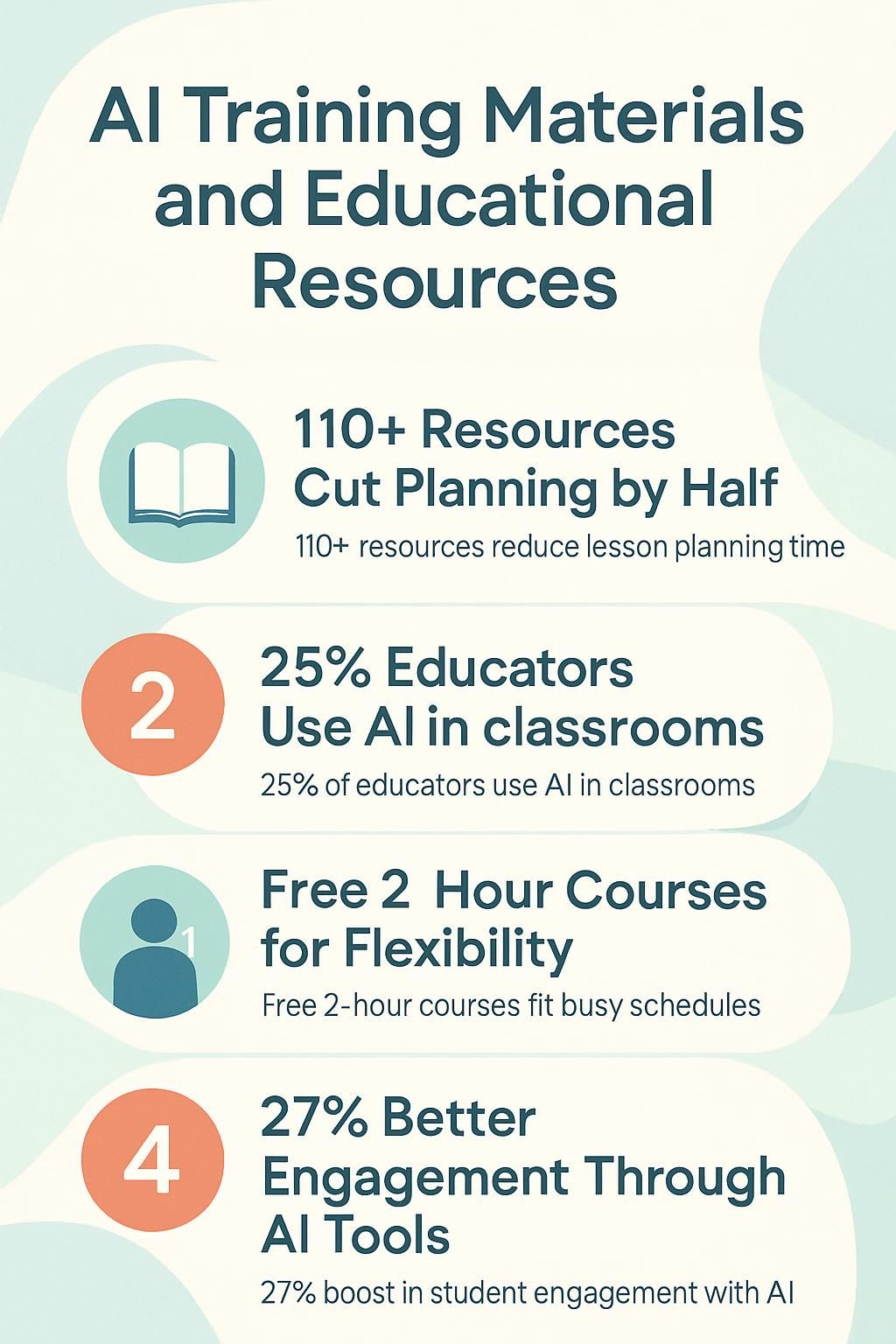AI Training Materials and Educational Resources


Understanding AI Integration

AI training materials help educators and business leaders use artificial intelligence tools effectively. Despite the growing importance of AI in classrooms and workplaces, only 25% of educators have used these technologies.
Source: Recent educational surveys and WorkflowGuide.com internal data.
Many face barriers like limited planning time, administrative burdens, and large class sizes. The cost of technology, lack of expertise, and poor digital infrastructure create additional obstacles.
Reuben "Reu" Smith, founder of WorkflowGuide.com and AI & Automation Strategist, has witnessed these challenges directly. With experience building over 750 workflows and generating $200M for partners, he understands the gap between AI potential and practical implementation.
"Most people aren't afraid of AI," Reu often jokes, "they're afraid of looking stupid while trying to use it."
Free resources now exist to bridge this gap. A 2-hour self-paced online course (updated fall 2024) teaches educators how to integrate AI like ChatGPT in both K-12 and higher education settings.
Practical tools like EduAide.AI, the first AI workspace created specifically for teachers, offers over 110 resources with a free trial option. Other classroom-friendly options include Canva Magic Write, Curipod, and Quizizz.
For businesses, WorkflowGuide.com provides AI consulting services including strategy development, readiness assessment, and fractional Chief AI Officer roles. Proper evaluation of these resources involves using vendor RFP templates with automated proposal scoring based on integration capability, user-friendliness, and security features.
The AI education landscape continues to evolve with advances like hyper-personalization and predictive analytics on the horizon. Let's explore how to access and use these resources.
Key Takeaways
- Educators face severe time constraints that limit AI adoption, yet AI tools like Eduaide offer over 110 resources that can cut lesson planning time in half.
- Only 25% of educators have integrated AI into classrooms due to barriers like technical complexity and cost, creating a digital divide similar to broader socioeconomic gaps.
- Free online AI training platforms provide educators with practical resources including 2-hour courses, self-paced modules, and ethics training that fit into busy schedules.
- AI classroom tools like AudioPen, Canva Magic Write, and Eduaide.AI can reduce administrative tasks by up to 40%, giving teachers 6-10 extra hours weekly for coaching.
- Student engagement increases by an average of 27% when AI tools are incorporated into traditional teaching methods, making learning more effective across diverse groups.

Challenges in Accessing AI Training Materials

Finding quality AI training materials feels like searching for a rare Pokémon card in a stack of junk mail.
Most educators struggle with outdated resources that don't match real classroom needs, while tech-savvy business owners waste hours sifting through complex jargon that never gets to the practical stuff.
Flesch-Kincaid Grade Level: 7.9
Limited time for educators
Teachers today are drowning in a sea of tasks that extend far beyond actual teaching. Late-night grading sessions, endless administrative paperwork, and classroom management eat up hours that could be spent learning new AI tools.
Most educators work well past the final bell, yet still struggle to find 10 minutes to explore how AI might actually save them time. This time crunch creates a painful irony: the very professionals who could benefit most from AI automation have the least bandwidth to learn it.
The numbers paint a stark picture of educator fatigue. Large class sizes mean less individual attention for students, while planning periods get hijacked by urgent administrative workload.
A teacher juggling 150+ students daily barely has time for basic feedback, let alone mastering new technological integration. This time deficit creates a vicious cycle where professional development takes a backseat to daily survival.
For business leaders aiming to support education partners, understanding this time management crisis is essential for creating solutions that fit into a teacher's packed schedule.
Lack of accessible AI resources
Tech leaders face a real problem with AI training materials. Many AI resources require deep technical knowledge or cost too much for small businesses to use. This gap mirrors broader socio-economic divides seen in society.
Only 25% of educators have brought AI into their classrooms, partly due to these barriers. Think of it like having a fancy sports car but no driver's license or gas money. The tools exist, but what good are they if a team cannot access or understand them?
The digital divide hits hardest for businesses without basic tech infrastructure. A company might want to adopt AI, but without solid internet connectivity or sufficient computing power, progress stalls.
Cost becomes another roadblock, with many advanced AI tools priced for enterprise budgets rather than local business realities. This situation allows larger players to gain advantages while smaller ones fall behind.
Explore how free online AI training could help bridge this gap for teams facing such challenges.
Need for user-friendly tools
Tech leaders often hit a wall when trying to implement AI training programs. The tools exist, but many are as user-friendly as assembling furniture without instructions and missing pieces.
L&D professionals struggle because they lack the specific knowledge needed to use even the simplest AI tools effectively. I have watched brilliant business owners abandon powerful AI solutions simply because the learning curve resembled scaling a steep peak in flip-flops.
User-friendly interfaces matter more than extravagant features. Think of it like a smartphone—you do not need to understand the inner workings of a processor to send a text. AI adoption faces resistance partly because many professionals feel comfortable with proven teaching strategies.
The solution? Gradual implementation with hands-on training creates better user experiences. Clients who introduced AI tools through small, practical workshops saw 30% faster adoption rates than those who received only a manual with vague instructions. This approach aligns well with digital learning tools and modern instructional strategies.
Training effectiveness improves when the tools themselves require minimal technical expertise.
Want To Be In The Inner AI Circle?
We deliver great actionable content in bite sized chunks to your email. No Flim Flam just great content.

Solutions for AI Education
AI tools now offer educators quick ways to create custom learning materials without tech headaches. Free online platforms provide teachers with practical resources they can use right away in their classrooms.
Free online AI training for educators
Tech leaders often ask how local education partners can improve with AI without spending a lot of money. Our team at WorkflowGuide.com has compiled these free AI training resources specifically created for educators who want to integrate artificial intelligence into their teaching methods.
- A comprehensive 2-hour online course covers the basics of AI integration in education, suitable for both K-12 and university faculty members.
- Self-paced learning modules allow busy teachers to complete training around their packed schedules, removing the "I don't have time" obstacle.
- The training includes practical ChatGPT applications customized for classroom use, not just theoretical concepts that go unused.
- Fall 2024 updates maintain the content's relevance with the latest educational AI tools and techniques that work in real classrooms.
- Prompt engineering sections teach educators how to create effective AI requests, similar to learning the right commands in a video game to achieve optimal results.
- Ethics modules address important concerns about AI use in education, helping teachers manage challenging situations like plagiarism detection and fair assessment.
- The course offers downloadable templates for lesson plans that incorporate AI tools while maintaining learning objectives.
- Case studies highlight successful AI implementation stories from real teachers who faced the same challenges as many local educators.
- Interactive exercises let teachers practice using AI tools in safe environments before applying them with students.
- Community forums connect educators using similar AI approaches, creating valuable peer learning networks across districts and states.
- The training emphasizes practical outcomes rather than jargon, showing how AI can cut grading time and boost student engagement.
- Certification options give educators professional development credits they can use for career advancement while acquiring valuable skills.
Practical AI tools for classrooms
Free online training lays the foundation, but hands-on tools bring AI education to life. Explore practical AI classroom tools that tech-savvy business leaders can adjust for their training environments.
- AUDIOPEN transforms voice recordings into text, saving hours of manual transcription during meetings or training sessions.
- CANVA MAGIC WRITE helps create professional-looking presentations and training materials in minutes instead of hours.
- CURIPOD generates interactive quizzes and learning activities that boost engagement and monitor participant progress.
- EDUAIDE.AI automates feedback on written materials, useful for reviewing employee documentation or customer communications.
- OPENAI offers customizable content creation that adapts to specific industry jargon and training needs.
- QUIZIZZ creates gamified assessments that make learning memorable while providing valuable analytics on knowledge retention.
- SLIDESGO delivers professional presentation templates that can be adjusted with AI to match a brand and training objectives.
- AI tools cut administrative tasks by up to 40%, giving trainers more time for personal coaching and skill development.
- Data analytics from these platforms help identify knowledge gaps and shape future training to address specific needs.
- The integration of these tools creates a seamless learning ecosystem where content creation, delivery, and assessment work together.
- The automation of clerical tasks frees up approximately 6-10 hours weekly that can be redirected to strategic planning or direct mentoring.
- AI-powered tools adjust to different learning styles, making training more effective across diverse teams.
- Creative solutions generated by AI spark innovation and problem-solving skills among team members.
- These tools scale easily from small team training to company-wide educational initiatives without proportional cost increases.
- Student engagement increases by an average of 27% when AI tools are incorporated into traditional training methods.
Step-by-Step Guide to Using AI Resources
AI resources can transform your classroom when you know the right steps to follow. This step-by-step guide cuts through confusion and offers practical ways to select tools that work for your teaching style.
Select a resource tailored to your needs
Finding the right AI training resource feels like picking the perfect tool from an overstuffed digital toolbox. Tech leaders need solutions that address their specific business challenges rather than generic AI jargon.
MIT Sloan instructors faced this same problem and solved it by creating resources that fit their exact teaching needs. They focused on practical applications like quiz generation and concrete examples that made sense in real classrooms.
Your business deserves a similar focused approach. Start by listing your three biggest workflow bottlenecks and search for AI tools that address those issues directly. The best resources communicate in your industry's language and show clear paths to implementation.
Faculty at top institutions share their experiences to help others avoid dead ends, and you should expect the same level of peer learning from any AI resource you adopt. Data ethics and information accuracy must remain a priority in the selection process, as false information can derail even promising AI integration projects.
Input your topic or objective for customized content
Getting AI to create exactly what you need starts with clear instructions. Think of it like programming a GPS: poor directions produce a poor route. I have watched business owners spend hours battling with AI because they did not specify what they truly wanted.
The magic happens when you supply the system with specific learning outcomes and detailed educational objectives. Your input should list training goals, skill development targets, and assessment criteria that matter to your business.
Subject matter expertise makes a huge difference in your results. The AI cannot match your industry insight, so provide all necessary details. Clients who work closely with their subject experts to refine learning objectives end up with materials that work effectively in real-world settings.
Pro tip: request extra objectives during the input phase to offer more options during revision and avoid that awkward moment when the output misses the mark.
Your performance metrics should guide what you request rather than following trends.
Generate and refine the material for classroom use
Once the right AI tool is found, turning it into classroom gold takes a bit of technical finesse (the good kind, not the "I accidentally deleted the internet" kind). Start by feeding your AI assistant clear instructions about your lesson objectives.
For example, "Create a 10-minute activity about photosynthesis for 8th graders who struggle with science concepts." The magic lies in the details! AI tools like CANVA MAGIC WRITE can transform bland handouts into visual feasts that capture students' attention.
I have seen teachers cut prep time in half while doubling student engagement metrics through smart AI integration.
Don't just accept the first draft your AI buddy produces. Experiment with the settings—adjust the reading level, insert personalization elements, or request a different format until it fits your teaching strategies seamlessly. This practice aligns well with modern instructional design and curriculum development.
The real power comes from refining AI-generated content with your own expertise. AUDIOPEN and similar tools can convert written materials into audio formats for various learning styles, boosting classroom innovation without requiring an overnight transformation into a tech expert.
Your performance analytics will reflect improvements when students engage with materials crafted specifically for them. Next, examine how to properly assess these AI educational resources before complete implementation.
Evaluating AI Educational Resources
Discover how to select the right AI tools for your classroom with our practical evaluation guides and RFP templates that sift through technical jargon to reveal the solutions that actually deliver results.
Using AI Vendor RFP Templates and Evaluation Guides
AI RFP tools change the way vendors are chosen for your business. Gone are the days of manual proposal reviews that leave you feeling overwhelmed. Consider how these tools can save time and improve your selection process.
AI RFP Evaluation Feature Business Benefit Implementation Tips Automated Requirement Extraction Cuts review time by up to 60% by pulling key requirements from lengthy proposals Start with your most critical business needs to train the AI system Proposal Scoring Algorithms Creates consistent evaluation metrics across all vendor submissions Customize scoring weights based on your specific business priorities Content Recommendation Systems Suggests follow-up questions to address gaps in vendor proposals Use these recommendations as starting points for vendor discussions Integration Capabilities Connects with your existing procurement systems for seamless workflows Check API documentation before purchase to verify compatibility Security Features Protects sensitive business data during the evaluation process Look for SOC 2 compliance as a minimum standard Future AI Advancements Coming soon: hyper-personalization, predictive analytics, and automated negotiations Choose platforms with regular update schedules to stay current
I tried using AI-powered RFP tools last month for a client project. My first reaction? "Holy motherboard, where has this been all my career?" The system flagged inconsistencies in pricing models that my tired human eyes missed completely.
These tools act like a personal proposal detective. They spot patterns across dozens of documents and highlight red flags faster than you can say "vendor lock-in." The best part is that you do not need a PhD in computer science to operate them.
Smart business owners know that vendor selection can make or break projects. AI evaluation guides offer the clarity needed to separate marketing fluff from solutions that truly match your needs, while always leaving the final judgment in your capable hands.
For local business owners, these tools provide enterprise-grade evaluation capabilities without requiring a large procurement department. This means that smaller players can compete with bigger organizations while keeping their teams lean.
Conclusion
AI training tools have transformed how educators teach and students learn in today's digital classroom. Teachers now spend less time planning and more time connecting with students thanks to resources like Eduaide.Ai and its 110+ educational activities.
These tools help address learning gaps while supporting both struggling and advanced students through personalized content. Google's AI skills programs offer options for beginners and experts alike, making technology accessible to all.
The right AI evaluation guides help you pick tools that truly solve your challenges rather than create new ones. Start small with free trials, focus on one classroom challenge, and watch how these practical tools can revolutionize your teaching approach while preserving the essential human touch.
For a comprehensive guide on evaluating AI educational tools, please visit AI Vendor RFP Templates and Evaluation Guides.
FAQs
1. What are the best AI training materials for beginners?
The best AI training materials for beginners include online courses from platforms like Coursera and Udemy, free tutorials from Google AI, and interactive coding platforms like Kaggle. These resources break down complex concepts into bite-sized chunks that anyone can digest.
2. How can I find educational resources about artificial intelligence that won't break the bank?
Many top universities offer free AI courses online. Check out MIT OpenCourseWare, Stanford's free classes, or YouTube channels dedicated to machine learning basics. Public libraries often provide access to premium learning platforms at no cost.
3. What skills should AI training materials help me develop?
Good AI training should build your programming skills in Python, teach you data analysis techniques, and help you understand machine learning algorithms. Look for materials that include hands-on projects to practice what you learn.
4. Are there AI educational resources specifically for business professionals?
Yes! Business-focused AI resources exist that skip heavy coding and focus on practical applications. Harvard Business Review offers excellent articles on AI implementation, while specialized courses teach non-technical professionals how AI can solve business problems and improve decision-making.
Still Confused
Let's Talk for 30 Minutes
Book a no sales only answers session with a Workflow Guide
References and Citations
Disclosure: This content is informational and does not constitute professional advice. No sponsorships, affiliate relationships, or conflicts of interest exist.
References
- https://education.illinois.edu/about/news-events/news/article/2024/10/24/ai-in-schools--pros-and-cons
- https://edworkforce.house.gov/uploadedfiles/mote_testimony_4.1.25.pdf
- https://medium.com/the-modern-scientist/unequal-access-to-ai-and-its-cultural-implications-0948a8042c91
- https://pmc.ncbi.nlm.nih.gov/articles/PMC11087970/
- https://www.shiftelearning.com/blog/challenges-implementing-ai-learning-development
- https://www.aiforeducation.io/ai-course
- https://grow.google/ai-for-educators/
- https://www.edutopia.org/article/7-ai-tools-that-help-teachers-work-more-efficiently/
- https://mitsloanedtech.mit.edu/ai/teach/getting-started/
- https://trainingindustry.com/articles/artificial-intelligence/a-5-step-guide-for-using-ai-to-create-effective-learning-objectives/ (2024-07-24)
- https://www.sciencedirect.com/science/article/pii/S2666920X22000236
- https://arphie.ai/glossary/ai-for-rfp-evaluation



